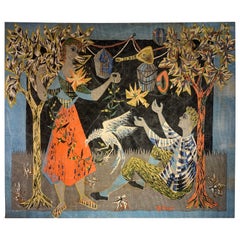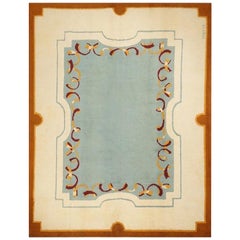Robert Debieve On Sale
Recent Sales
Mid-20th Century French Art Deco Tapestries
Canvas, Wood
Vintage 1940s European Art Deco Western European Rugs
Wool
Late 20th Century French Art Deco Tapestries
Canvas
Mid-20th Century French Art Deco Tapestries
Canvas
Vintage 1950s French Mid-Century Modern Tapestries
Cotton
A Close Look at Art-deco Furniture
Art Deco furniture is characterized by its celebration of modern life. More than its emphasis on natural wood grains and focus on traditional craftsmanship, vintage Art Deco dining chairs, tables, desks, cabinets and other furniture — which typically refers to pieces produced during the 1920s and 1930s — is an ode to the glamour of the “Roaring Twenties.”
ORIGINS OF ART DECO FURNITURE DESIGN
- Emerged in the 1920s
- Flourished while the popularity of Art Nouveau declined
- Term derives from 1925’s Exposition Internationale des Arts Décoratifs et Industriels Modernes (International Exhibition of Modern Decorative and Industrial Arts) in Paris, France
- Informed by Ancient Egypt, Cubism, Futurism, Louis XVI, De Stijl, modernism and the Vienna Secession; influenced Streamline Moderne and mid-century modernism
CHARACTERISTICS OF ART DECO FURNITURE DESIGN
- Bold geometric lines and forms, floral motifs
- Use of expensive materials such as shagreen or marble as well as exotic woods such as mahogany, ebony and zebra wood
- Metal accents, shimmering mirrored finishes
- Embellishments made from exotic animal hides, inlays of mother-of-pearl or ivory
ART DECO FURNITURE DESIGNERS TO KNOW
VINTAGE ART DECO FURNITURE ON 1STDIBS
Few design styles are as universally recognized and appreciated as Art Deco. The term alone conjures visions of the Roaring Twenties, Machine Age metropolises, vast ocean liners, sleek typography and Prohibition-era hedonism. The iconic movement made an indelible mark on all fields of design throughout the 1920s and ’30s, celebrating society’s growing industrialization with refined elegance and stunning craftsmanship.
Widely known designers associated with the Art Deco style include Émile-Jacques Ruhlmann, Eileen Gray, Maurice Dufrêne, Paul Follot and Jules Leleu.
The term Art Deco derives from the name of a large decorative arts exhibition held in Paris in 1925. “Art Deco design” is often used broadly, to describe the work of creators in associated or ancillary styles. This is particularly true of American Art Deco, which is also called Streamline Moderne or Machine Age design. (Streamline Moderne, sometimes known as Art Moderne, was a phenomenon largely of the 1930s, post–Art Nouveau.)
Art Deco textile designers employed dazzling floral motifs and vivid colors, and while Art Deco furniture makers respected the dark woods and modern metals with which they worked, they frequently incorporated decorative embellishments such as exotic animal hides as well as veneers in their seating, case pieces, living room sets and bedroom furniture.
From mother-of-pearl inlaid vitrines to chrome aviator chairs, bold and inventive works in the Art Deco style include chaise longues (also known as chaise lounges) and curved armchairs. Today, the style is still favored by interior designers looking to infuse a home with an air of luxury and sophistication.
The vintage Art Deco furniture for sale on 1stDibs includes dressers, coffee tables, decorative objects and more.
Finding the Right Tapestry for You
Whether you hang them behind your bed as a dazzling alternative to a headboard or over the sofa as a large-scale focal point in the living room, vintage tapestries can introduce an array of textures and colors to any space in your home.
Woven wall hangings haven’t consistently enjoyed the popularity or earned the highbrow status that other types of wall decorations have over the years, at least not since the 1970s, which was somewhat of a heyday for tapestries. Today, however, these tactile works of art are seeing a renaissance, as modern weavers are forging new paths in the medium while the demand for antique and vintage tapestries continues to grow.
“We are drawn to texture in environments, and we see tapestries as a subtle layer of soft ornament,” says Lauren Larson of the New York design duo Material Lust. Indeed, and a lot of opportunity comes along when decorating with this distinctive brand of soft ornament.
Think of wall hangings as paintings created by hand with fabric instead of oil or watercolors. If you’re not simply securing your treasure to a wall with nails, pushpins or Velcro, tapestries can be stretched over a frame, used to create a canopy in a cozy living-room corner, hung from a rod or placed inside a shadowbox. And because this kind of textile art is hundreds of years old, options abound with respect to subjects and designs.
For richly detailed depictions of landscapes and garden scenes, look to antique Chinese tapestries and Japanese tapestries. Aubusson tapestries are ornate wall hangings manufactured in central France that are also characterized by romantic portrayals of nature. For weavers of mid-century modern tapestries, as well as those working in textile arts today, the styles and subject matter are too numerous to mention, with artists exploring experimental shapes, bold colors and provocative abstract designs.
Antique, new and vintage tapestries can make a room feel warm and welcoming — find yours on 1stDibs now.

